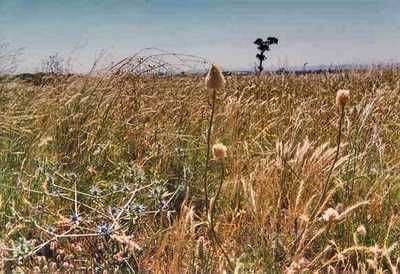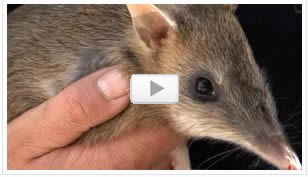
Pinkerton Forest
 Pinkerton Landcare & Environment Group (PLEG) is concerned with the restoration of native grasslands and grassy grey-box woodlands, including the grassy woodland of Pinkerton Forest, the nearby native grassland in Mulla Mulla Grasslands (Bush's Paddock) and of the adjacent section of the Werribee River Volcanic Gorge, (which adjoins Western Water Treatment Plant at Surbiton Park) within the City of Melton, Victoria, Australia.
Pinkerton Landcare & Environment Group (PLEG) is concerned with the restoration of native grasslands and grassy grey-box woodlands, including the grassy woodland of Pinkerton Forest, the nearby native grassland in Mulla Mulla Grasslands (Bush's Paddock) and of the adjacent section of the Werribee River Volcanic Gorge, (which adjoins Western Water Treatment Plant at Surbiton Park) within the City of Melton, Victoria, Australia.
View a map of our restoration sites
View photos of Pinkerton Forest
| Plant List | ||||||||||||||||||||||||||||||||||||||||||||||||||||||||||||||||||||||||||||||||||||||||||||||||||||||||||||||||||||||||||||||||||||||||||||||||||||||||||||||||||||||||||||||||||||||||||||||||||||||||||||||||||||||||||||||||||||||||||||||||||||||||||||||||||||||||||||||||||||||||||||||||||||||||||||||||||||||||||||||||||||||||||||||||||||||||||||||||||||||||||||||||||||||||||||||||||||||||||||||||||||||||||||||||||||||||||||||||||||||||||||||||||||||||||||||||||||||||||||||||||||||||||||||||||||||||||||||||||||||||||||||||||||||||||||||||||||||||||||||||||||||||||||||||||||||||||||||||||||||||||||||||
|
The plant list was compiled by Doug Frood May 2003 (Wildlife Profiles Pty Ltd) |
||||||||||||||||||||||||||||||||||||||||||||||||||||||||||||||||||||||||||||||||||||||||||||||||||||||||||||||||||||||||||||||||||||||||||||||||||||||||||||||||||||||||||||||||||||||||||||||||||||||||||||||||||||||||||||||||||||||||||||||||||||||||||||||||||||||||||||||||||||||||||||||||||||||||||||||||||||||||||||||||||||||||||||||||||||||||||||||||||||||||||||||||||||||||||||||||||||||||||||||||||||||||||||||||||||||||||||||||||||||||||||||||||||||||||||||||||||||||||||||||||||||||||||||||||||||||||||||||||||||||||||||||||||||||||||||||||||||||||||||||||||||||||||||||||||||||||||||||||||||||||||||||
| k = poorly known | ||||||||||||||||||||||||||||||||||||||||||||||||||||||||||||||||||||||||||||||||||||||||||||||||||||||||||||||||||||||||||||||||||||||||||||||||||||||||||||||||||||||||||||||||||||||||||||||||||||||||||||||||||||||||||||||||||||||||||||||||||||||||||||||||||||||||||||||||||||||||||||||||||||||||||||||||||||||||||||||||||||||||||||||||||||||||||||||||||||||||||||||||||||||||||||||||||||||||||||||||||||||||||||||||||||||||||||||||||||||||||||||||||||||||||||||||||||||||||||||||||||||||||||||||||||||||||||||||||||||||||||||||||||||||||||||||||||||||||||||||||||||||||||||||||||||||||||||||||||||||||||||||
| hr = high regional significance (potentially extinction prone) | ||||||||||||||||||||||||||||||||||||||||||||||||||||||||||||||||||||||||||||||||||||||||||||||||||||||||||||||||||||||||||||||||||||||||||||||||||||||||||||||||||||||||||||||||||||||||||||||||||||||||||||||||||||||||||||||||||||||||||||||||||||||||||||||||||||||||||||||||||||||||||||||||||||||||||||||||||||||||||||||||||||||||||||||||||||||||||||||||||||||||||||||||||||||||||||||||||||||||||||||||||||||||||||||||||||||||||||||||||||||||||||||||||||||||||||||||||||||||||||||||||||||||||||||||||||||||||||||||||||||||||||||||||||||||||||||||||||||||||||||||||||||||||||||||||||||||||||||||||||||||||||||||
|
r = regional significance |
||||||||||||||||||||||||||||||||||||||||||||||||||||||||||||||||||||||||||||||||||||||||||||||||||||||||||||||||||||||||||||||||||||||||||||||||||||||||||||||||||||||||||||||||||||||||||||||||||||||||||||||||||||||||||||||||||||||||||||||||||||||||||||||||||||||||||||||||||||||||||||||||||||||||||||||||||||||||||||||||||||||||||||||||||||||||||||||||||||||||||||||||||||||||||||||||||||||||||||||||||||||||||||||||||||||||||||||||||||||||||||||||||||||||||||||||||||||||||||||||||||||||||||||||||||||||||||||||||||||||||||||||||||||||||||||||||||||||||||||||||||||||||||||||||||||||||||||||||||||||||||||||
|
Region = eastern part of western volcanics (east of Brisbane Ranges) |
||||||||||||||||||||||||||||||||||||||||||||||||||||||||||||||||||||||||||||||||||||||||||||||||||||||||||||||||||||||||||||||||||||||||||||||||||||||||||||||||||||||||||||||||||||||||||||||||||||||||||||||||||||||||||||||||||||||||||||||||||||||||||||||||||||||||||||||||||||||||||||||||||||||||||||||||||||||||||||||||||||||||||||||||||||||||||||||||||||||||||||||||||||||||||||||||||||||||||||||||||||||||||||||||||||||||||||||||||||||||||||||||||||||||||||||||||||||||||||||||||||||||||||||||||||||||||||||||||||||||||||||||||||||||||||||||||||||||||||||||||||||||||||||||||||||||||||||||||||||||||||||||
|
Note: may be others of significance, but not as high as those indicated, or extinction prone. |
||||||||||||||||||||||||||||||||||||||||||||||||||||||||||||||||||||||||||||||||||||||||||||||||||||||||||||||||||||||||||||||||||||||||||||||||||||||||||||||||||||||||||||||||||||||||||||||||||||||||||||||||||||||||||||||||||||||||||||||||||||||||||||||||||||||||||||||||||||||||||||||||||||||||||||||||||||||||||||||||||||||||||||||||||||||||||||||||||||||||||||||||||||||||||||||||||||||||||||||||||||||||||||||||||||||||||||||||||||||||||||||||||||||||||||||||||||||||||||||||||||||||||||||||||||||||||||||||||||||||||||||||||||||||||||||||||||||||||||||||||||||||||||||||||||||||||||||||||||||||||||||||
|
||||||||||||||||||||||||||||||||||||||||||||||||||||||||||||||||||||||||||||||||||||||||||||||||||||||||||||||||||||||||||||||||||||||||||||||||||||||||||||||||||||||||||||||||||||||||||||||||||||||||||||||||||||||||||||||||||||||||||||||||||||||||||||||||||||||||||||||||||||||||||||||||||||||||||||||||||||||||||||||||||||||||||||||||||||||||||||||||||||||||||||||||||||||||||||||||||||||||||||||||||||||||||||||||||||||||||||||||||||||||||||||||||||||||||||||||||||||||||||||||||||||||||||||||||||||||||||||||||||||||||||||||||||||||||||||||||||||||||||||||||||||||||||||||||||||||||||||||||||||||||||||||
Saving grassy woodland is not just a matter of saving and replanting the trees.
When protecting the whole environment of the grassy woodland (rather than just the woodland component) it is just as important to protect and regenerate the native grassland beneath the trees.
Many species of wildlife are dependant upon woodland and grassy woodland for their survival. Unfortunately these two habitats, once so widespread in the region to the west of Melbourne, are now greatly diminished and endangered, and the remnants are fast disappearing. Consequently, the wildlife species that depend upon these habitats are also threatened and endangered.
Diamond Firetail Finch
One such species that depends upon grassy woodlands for its continued survival is the Diamond Firetail Finch. This is a strikingly beautiful bird that is unfortunately threatened (as is its habitat). We are fortunate in having numbers of Diamond Firetails (among many other species) in Pinkerton & Bushes Paddock.
The Australian Bush Heritage Fund recently published an article on the Diamond Firetail in its magazine 'Bush Heritage News’:
“Diamond Firetail: Conservation status: near threatened, nationally
Diamond Firetails live in the eucalypt-dominated grassy woodlands of south-eastern Australia. Most of these habitats have been cleared or severely modified, making them unsuitable for the birds.
The firetails are also disappearing from small areas of remnant grassy woodland
One of the key factors causing the decline of the firetails is thought to be the replacement of native grasses with introduced pasture grass. Where grazing pressure from stock is high, the grasses also fail to set seed, thus depriving the firetails of their most important food.”
Australian Bush Heritage Fund
'Bush Heritage News Winter 2005'
The article refers to just one species of bird that is becoming nationally threatened. However, this applies to other species of wildlife also. It is imperative that the few surviving remnants of woodlands and grassy woodlands be protected.
Robins
Among the seasonal migrants are the robins. These are a spectacular sight, especially as they visit during the darker months of autumn and winter The male Scarlet Robin is unmistakeable, with its bright scarlet breast contrasting boldly with its back of velvet black, usually seen accompanied by several brown coloured female partners. They are a common sight here during the colder months. Occasionally its rarer relative, the Flame Robin is also seen, but this has a flame-red breast and a slatey-grey back. Unfortunately, robins are declining in numbers, probably due to habitat loss.
Blue Wren
Fortunately the beautiful Blue Wren, well known and loved by everyone, is common here all year round, as is the similar sized Yellow-tailed Thornbill (with its more subdued brownish plumage and bright yellow rump). Many of the smaller birds such as these depend on low bushes (not just large trees) in which to find shelter for nesting and protection.
Parrots
Parrots are a prominent feature of the woodlands, finding nesting sites in the many hollow trees, and in spring they are especially conspicuous, squabbling noisily with each other (and with the ever present exotic mynahs and starlings) over nest sites. Eastern Rosellas and Red-backed Parrots are commonly seen, and Galahs are also a common sight, with White Cockatoos and Corellas often seen flying overhead. The abundance of these parrots often causes us to overlook their brilliant colours.
Wedge-tailed Eagles
Often seen flying overhead are the majestic Wedge-tailed Eagles, as they search the ground below for rabbits, their main source of food. Whistling Kites and Little Eagles similarly soar above the grasslands and woodlands, also on the hunt for rabbits. Other hawks, large and small, fly among and above the trees, hunting for prey. Kestrels and Black-shouldered Kites hover over the grassland looking for insects and small birds, while falcons course the skies at great speed with long pointed wings, hunting larger birds. The occasional White-bellied Sea-eagle is sometimes seen flying over the adjacent Western Water treatment plant, and the nearby Melton Reservoir. This surprising visitor is similar to a Wedge-tailed Eagle, but has striking black & white coloration, and no long wedge-shaped tail.
Magpie Geese
Surprisingly, Magpie Geese can also be seen flying in the vicinity. These are large impressive looking water birds with bold black and white plumage. Due to drought conditions they are finding refuge on the adjoining ponds at Western Water Sewerage Works at Surbiton Park. These magnificent birds are familiar to all who have seen wildlife documentaries of Kakadu, not to mention featuring prominently in television adverts exhorting us to visit the Northern Territory. These birds were once a familiar sight in Victorian wetlands in the early years of settlement, but they were swiftly exterminated by a combination of extensive wetland drainage and uncontrolled market shooting to supply an eager market for fresh waterfowl at Victoria Market. They have been bred extensively at Lara Research Institute for many years, in hopes of their re-introduction into Victoria. Magpie Geese are now symbolic of the Far North, but their hopeful return to local wetlands would be a welcome sight.
Many other species of birds make their homes in Pinkerton & Bushes Paddock. Some live here permanently, while others are visitors only, migrating from other places at various times of the year. The Bird Observers Club conduct regular surveys of birds, and maintain a list of the birds found here, updating it at regular intervals.
The range of habitats in and around Pinkerton & Bushes Paddock ensures a healthy population of native birds. The grassy woodland itself adjoins a sizeable remnant of restored native grassland, while itself surrounded by farmland and grazing land. The nearby Werribee River corridor, separated from the woodlands by the Western Water treatment plants (with its large collection of treatment ponds) also ensures a healthy diversity of bird life in and around these two reserves.
Mulla Mulla Grassland Plants |
||
|
Mulla
Mulla Grasslands (Bush's Paddock) contains an extension of the Pinkerton
Woodland, however there is a cleared paddock between the two areas.
The majority of the vegetation on this 45ha paddock is native grasses
and herbs. |
|
|
|
|
|
|
|
|
|
|
|
|
|
|
|
|
|
|
Grasses |
||
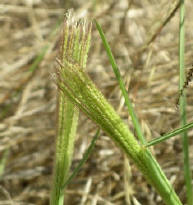 |
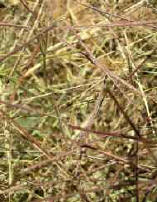 |
|
|
Chloris
truncata (Windmill Grass).
New Shoots (Left),Mature heads (Right) |
||
|
|
|
|
The Grassy Woodlands |
||
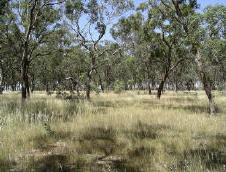 General View - Grassy Woodland |
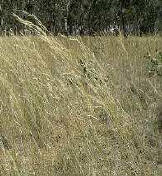 Native Spear Grass |
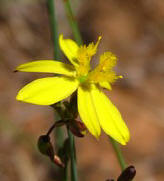 Tricoryne elatior (Yellow Rush Lily) |
 An old rock wall on-site |
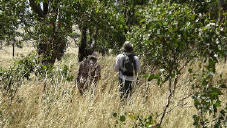 General View Walking in the tall grasses. |
Einadia nutans (Nodding Salt Bush) |
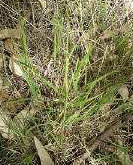 Low growing, Microlaeana stipodes (Weeping Grass ) |
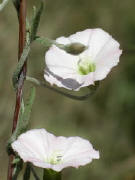 Convolvulus (Twining flower) |
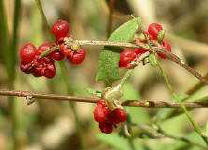 Ripe Berries of the Salt Bush |
Planting of Grassland species - Organised by Melton Shire |
||
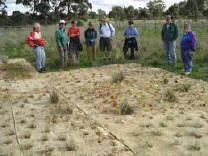 |
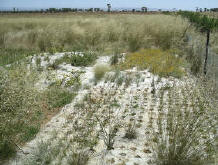 |
 |
|
The
initial planting of selected native plants were made using a special
weed mat, which would hopefully reduce the incidence of weeds and
promote the growth of native plants.
Four months later, the field grasses have grown (background) and the special plants in the weed mat have grown well. |
||
|
|
 Helichrysium apiculatum (Common Everlasting) |
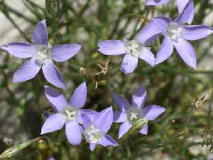 Wahlenbergia communis (Tufted Bluebell) |
|
Background |
 Photographs by Colin Rowan |
Mulla Mulla Grasslands (Bush's
Paddock) is a 45 hectare native grasslands site. It supports significant
remnants of Kangaroo Grassland and Greybox Grassy Woodland. |
Why Do We Bother! We see wide
open fields every time we go out into the country, vast fields of crops,
wheat, barley, canola etc, but as with pine plantations and the like these
are introduced, actual native grasslands are
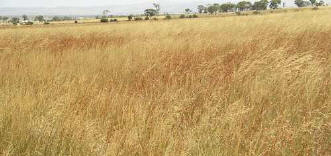 a
rare sight; less than 1% still remain. Could we cope if less than 1% of
forests were remaining? Native grasslands contain not just grasses, but
many other native plants as well. Plants such as Daises, Lilies, Orchids
abound. A healthy grassland prevents the invasion of the area by introduced
weeds. Bush's Paddock also contains a valuable stand of Grassy Woodland,
which apart from the grasses and plants provide a haven for wildlife and
also act as a wildlife corridor to adjoining forests. a
rare sight; less than 1% still remain. Could we cope if less than 1% of
forests were remaining? Native grasslands contain not just grasses, but
many other native plants as well. Plants such as Daises, Lilies, Orchids
abound. A healthy grassland prevents the invasion of the area by introduced
weeds. Bush's Paddock also contains a valuable stand of Grassy Woodland,
which apart from the grasses and plants provide a haven for wildlife and
also act as a wildlife corridor to adjoining forests.
Mulla Mulla Grasslands (Bush’s Paddock) is located in
the Shire of Melton on the western slope of Mt. Cotterell. It forms part of
the Victorian Volcanic Plains bioregion and contains the ecological
vegetation classes of plains grassland, plains grassy woodland. The average
rainfall is 450mm focusing on Mt. Cotterell ( height 204 meters).
Restoration planting has been undertaken using seeds from local provenance in the Mt. Cottrell/Exford region. Some of these have been propagated by members of the group. The planting of the threatened plant turkey-bush (eremophila deserti), propagated by a member of the group has been undertaken. Burning of dead boxthorn over winter, spot spraying serrated tussock during autumn and late winter/early spring are on-going maintenance jobs. In early spring it may be necessary to graze the annual grasses and broad-leafed weeds, and continue to spot spray phalaris aquatica. Further seed collection and propagation of understory species such as sticky everlasting (bracteantha viscosa) is a summer activity. Monitoring of emerging vegetation is undertaken using photography and mapping. Bird sightings are recorded and the Bird Observers Club Australia (BOCA) has undertaken to do quarterly surveys. Members of the group have monitored rabbits with spotlights, mapped and marked their holes and the rabbit proof fence is regularly checked. |
| Please contact the Shire of Melton for approval to visit Mulla Mulla Grasslands (Bush's Paddock). | |
|
Mulla Mulla Grasslands (Bush’s Paddock) is co-jointly managed by Pinkerton Landcare and the Shire of Melton. |
|
| The grasslands contain many important plants. One is the Tall Mulla Mulla which is of high regional signifiance - potententially extinction prone. Check the flora further here... | |
|
Ptilotus |
Ptilotus macrocephalus (featherheads).
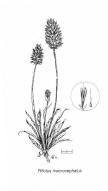 Drawing of the Ptilotus macrocephalus |
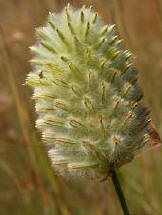
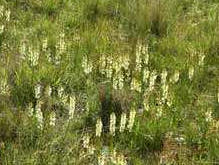

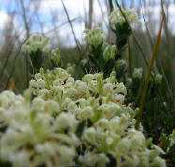
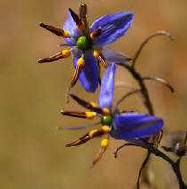
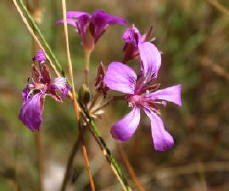
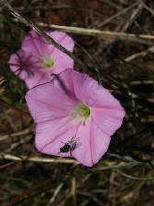
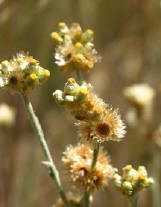
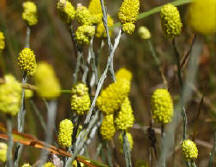
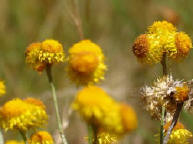
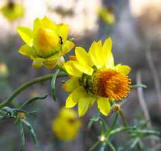
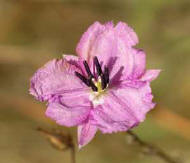

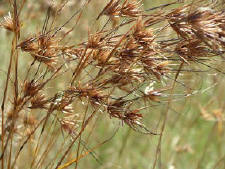
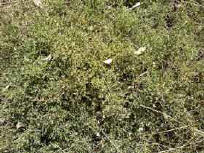
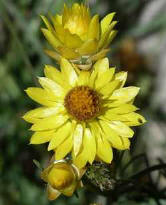
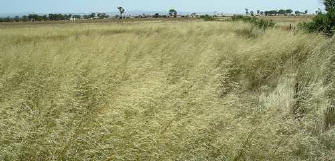 These
basalt plains grasslands are of State significance and are important as
there remains less than 1% of native grasslands in Victoria today. Pinkerton
Landcare and Environment Group co-jointly manages Bush's Paddock along with
the Shire of Melton.
These
basalt plains grasslands are of State significance and are important as
there remains less than 1% of native grasslands in Victoria today. Pinkerton
Landcare and Environment Group co-jointly manages Bush's Paddock along with
the Shire of Melton. 